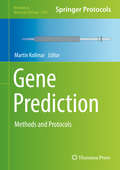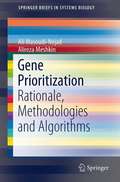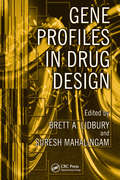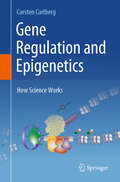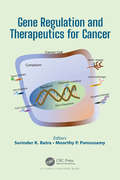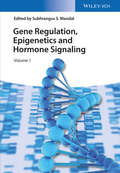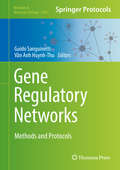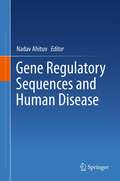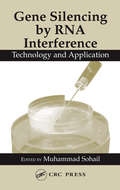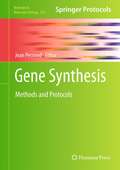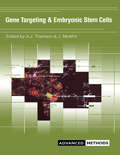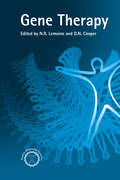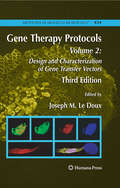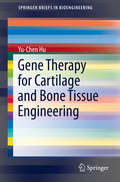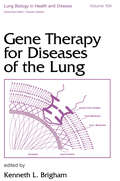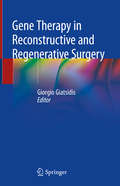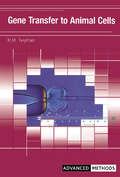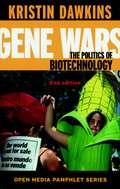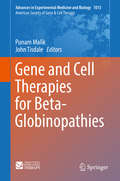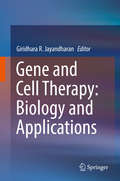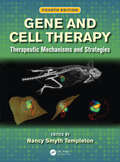- Table View
- List View
Gene Prediction: Methods and Protocols (Methods in Molecular Biology #1962)
by Martin KollmarThis volume introduces software used for gene prediction with focus on eukaryotic genomes. The chapters in this book describe software and web server usage as applied in common use-cases, and explain ways to simplify re-annotation of long available genome assemblies. Written in the highly successful Methods in Molecular Biology series format, chapters include introductions to their respective topics, lists of the necessary computational requirements, step-by-step, readily reproducible computational protocols, and tips on troubleshooting and avoiding known pitfalls.Cutting-edge and thorough, Gene Prediction: Methods and Protocols is a valuable resource for researchers and research groups working on the assembly and annotation of single species or small groups of species. Chapter 3 is available open access under a CC BY 4.0 license via link.springer.com.
Gene Prioritization
by Ali Masoudi-Nejad Alireza MeshkinIdentifying causal genes underlying susceptibility to human disease is a problem of primary importance in the post-genomic era and in current biomedical research. Recently, there has been a paradigm shift of such gene-discovery efforts from rare, monogenic conditions to common "oligogenic" or "multifactorial" conditions such as asthma, diabetes, cancers and neurological disorders. These conditions are referred to as multifactorial because, susceptibility to these diseases is attributed to the combinatorial effects of genetic variation at a number of different genes and their interaction with relevant environmental exposures. The goal of this book is to introduce gene prioritization aspects and the candidate gene prioritization algorithms to give readers a comprehensive view on the subject.
Gene Probes
by Ralph Rapley Marilena Aquino do MuroSenior scientists Marilena Aquino de Muro and Ralph Rapley have brought together an outstanding collection of time-tested protocols for designing and using genes probes in a wide variety of applications. The applications covered range from searching for specific genes in the human chromosome to the detection of microorganisms and their toxins in the environment and in food samples, as well as in the diagnosis of human disease. Helpful tutorials explain the principles of gene probe design, labeling, detection, target formation, and hybridization conditions.
Gene Profiles in Drug Design
by Brett A. Lidbury Suresh MahalingamWith the successful mapping of the human genome, we have entered an age of unprecedented opportunity in which researchers are beginning to apply this vast repository of knowledge to the treatment of human disease. Gene-profiling technologies and the concept of individualized medicine are leading to the development of drugs with enhanced specificity
Gene Regulation and Epigenetics: How Science Works
by Carsten CarlbergThis book delves into the fascinating realm of eukaryotic gene regulation. The specific expression of genes shapes the phenotype of cells and tissues. The regulation of gene expression, including up- and downregulation, is a fundamental aspect of nearly all physiological processes, both in health and disease. These dynamic processes respond to various daily challenges, such as dietary changes and infections. Therefore, it is crucial for not only biologists and biochemists but also all students in biomedical disciplines to understand gene regulation concepts. This foundational knowledge will benefit them in their specialized fields. A comprehensive understanding of transcription factors and the mechanisms that alter their activity is a fundamental goal of modern life science research. Epigenetics refers to the packaging and accessibility of the genome in each of the trillions of cells in our bodies. The prefix “epi” (meaning “upon,” “above,” or “beyond”) indicates that epigenetic processes do not alter the DNA sequence of our genome, adding a layer of information beyond that encoded in our genome. Genomic DNA is wrapped around complexes of histone proteins, helping it fit into a cell nucleus with a diameter of less than 10 μm. This protein-DNA complex is known as chromatin. The content of this book is linked to the “Molecular Medicine and Genetics” course, which the author has lectured on in various forms since 2002 at the University of Eastern Finland in Kuopio. This book is an updated version of the textbooks “Mechanisms of Gene Regulation” and “Human Epigenomics.” It is divided into 16 chapters. Following two introductory chapters, four chapters explore gene regulation from the perspective of transcription factors, while another four chapters focus on chromatin and non-coding RNA. Three chapters then discuss the impact of epigenetics from a health perspective, and the final three chapters address epigenetics from the perspective of diseases. A glossary in the appendix explains the major specialist terms.
Gene Regulation and Therapeutics for Cancer
by Surinder K. BatraDifferential gene regulation and targeted therapy are the critical aspects of several cancers. This book covers specific gene regulation and targeted therapies in different malignancies. It offers a comprehensive assessment of the transcriptional dysregulation in cancer, and considers some examples of transcriptional regulators as definitive oncogenic drivers in solid tumors, followed by a brief discussion of transcriptional effectors of the programs they drive, and discusses its specific targets. Most targeted therapeutics developed to date have been directed against a limited set of oncogenic drivers, exemplified by those encoding cell surface or cytoplasmic kinases that function in intracellular signaling cascades.
Gene Regulation, Epigenetics and Hormone Signaling
by Subhrangsu S. MandalThe first of its kind, this reference gives a comprehensive but concise introduction to epigenetics before covering the many interactions between hormone regulation and epigenetics at all levels. The contents are very well structured with no overlaps between chapters, and each one features supplementary material for use in presentations. Throughout, major emphasis is placed on pathological conditions, aiming at the many physiologists and developmental biologists who are familiar with the importance and mechanisms of hormone regulation but have a limited background in epigenetics.
Gene Regulatory Networks: Methods And Protocols (Methods in Molecular Biology #1883)
by Guido Sanguinetti Vân Anh Huynh-ThuThis volume explores recent techniques for the computational inference of gene regulatory networks (GRNs). The chapters in this book cover topics such as methods to infer GRNs from time-varying data; the extraction of causal information from biological data; GRN inference from multiple heterogeneous data sets; non-parametric and hybrid statistical methods; the joint inference of differential networks; and mechanistic models of gene regulation dynamics. Written in the highly successful Methods in Molecular Biology series format, chapters include introductions to their respective topics, descriptions of recently developed methods for GRN inference, applications of these methods on real and/ or simulated biological data, and step-by-step tutorials on the usage of associated software tools.Cutting-edge and thorough, Gene Regulatory Networks: Methods and Protocols is an essential tool for evaluating the current research needed to further address the common challenges faced by specialists in this field.
Gene Regulatory Sequences and Human Disease
by Nadav AhituvIn Gene Regulatory Sequences and Human Disease, the Editor will introduce the different technological advances that led to this breakthrough. In addition, several examples will be provided of nucleotide variants in noncoding sequences that have been shown to be associated with various human diseases.
Gene Silencing by RNA Interference: Technology and Application
by Muhammad SohailMaximizing the potential of RNA interference in functional genomics - as well as in the development of therapeutics - continues to be at the forefront of biomedical research. Unlike journal articles, Gene Silencing by RNA Interference: Technology and Application combines essential background to the RNAi field with practical techniques designed by r
Gene Synthesis
by Jean PeccoudThe de novo fabrication of custom DNA molecules is a transformative technology that significantly affects the biotechnology industry. Basic genetic engineering techniques for manipulating DNA in vitro opened an incredible field of opportunity in the life sciences. In, Gene Synthesis: Methods and Protocols expert researchers in the field detail many of the methods which are now commonly used to fabricate DNA . These include methods and techniques for the assembly of oligonucleotide, cloning of synthons into larger fragments, protocols and software applications, and educational and biosecurity impacts of gene synthesis. Written in the highly successful Methods in Molecular BiologyTM series format, the chapters include the kind of detailed description and implementation advice that is crucial for getting optimal results in the laboratory. Thorough and intuitive, Gene Synthese: Methods and Protocols aids scientists in understanding all the different stages of a complex gene synthesis process, while refining their understanding of gene synthesis and determine what part of the process they can or should do in their laboratory and what parts should be contracted to a specialized service provider.
Gene Targeting and Embryonic Stem Cells (Advanced Methods)
by Alison Thomson Jim McwhirGene Targeting and Embryonic Stem Cells is a practical guide designed for the rapidly growing number of researchers who are moving into this field. Provides details on how to culture, transfect and differentiate established cell lines, and how to isolate new cell lines. Gene targeting experiments are described for a number of cell types, including ungulate fetal fibroblasts, murine ES cells, human embryonal carinoma cells and human ES cells, and include protocols for gene-targeting vectors, DNA transfection and RNA interference. The recent isolation of human embryonic stem cells and the potential of these cells for therapeutic applications has generated an entirely new methodology. Similarly, gene targeting methodology has recently been extended to nuclear donor cells in ungulate species. This volume will be invaluable for both new and established researchers in the field of human embryonic stem cells, and to biotech companies engaged in the production of transgenic proteins in livestock, xenotransplantation and the development of animal models.
Gene Therapy (Medical Perspectives Ser.)
by Nicholas R. Lemoine David N. CooperGene Therapy describes the delivery systems now available to target a given tissue with specific gene or oligonucleotide sequences, and explores the utility of animal modules as test systems. In the context of selected disease states, it summarises in vitro and in vivo studies and clinical trials performed to date.
Gene Therapy , Third Edition, Volume 2: Design and Characterization of Gene Transfer Vectors
by Joseph LedouxIn Gene Therapy Protocols, Volumes 1 & 2, internationally recognized investigators describe cutting-edge laboratory techniques for the study of Production and In Vivo Applications of Gene Transfer Vectors (Volume 1) and Design and Characterization of Gene Transfer Vectors (Volume 2). The field of gene therapy has undergone remarkable advances, promising to impact human healthcare significantly in the twenty-first century. Today’s technologies can deliver genetic material safely and effectively to cells to slow or halt the progression of disease, and to help repair or regenerate damaged or lost tissues. In this second volume of Gene Therapy Protocols: Design and Characterization of Gene Transfer Vectors, readers will find a comprehensive resource of current and emerging methods for the processing and characterization of viral and non-viral gene transfer vectors, as well as promising approaches to design vectors for efficient, targeted and regulated gene delivery and expression. This second volume of the new and completely revised third edition of Gene Therapy Protocols will prove a necessary tool for graduate students and postdoctoral fellows and invaluable to basic and clinical researchers in both industry and academia.
Gene Therapy for Cartilage and Bone Tissue Engineering
by Yu-Chen Hu"Gene Therapy for Cartilage and Bone Tissue Engineering" outlines the tissue engineering and possible applications of gene therapy in the field of biomedical engineering as well as basic principles of gene therapy, vectors and gene delivery, specifically for cartilage and bone engineering. It is intended for tissue engineers, cell therapists, regenerative medicine scientists and engineers, gene therapist and virologists. Dr. Yu-Chen Hu is a Distinguished Professor at the Department of Chemical Engineering, National Tsing Hua University and has received the Outstanding Research Award (National Science Council), Asia Research Award (Society of Chemical Engineers, Japan) and Professor Tsai-Teh Lai Award (Taiwan Institute of Chemical Engineers). He is also a fellow of the American Institute for Medical and Biological Engineering (AIMBE) and a member of the Tissue Engineering International & Regenerative Medicine Society (TERMIS)-Asia Pacific Council.
Gene Therapy for Diseases of the Lung (Lung Biology In Health And Disease Ser.)
by Kenneth L. BrighamThis up-to-the-minute and comprehensive resource lucidly covers gene therapy for lung diseases from existing technologies delivering foreign DNA to the lungs via the airways or circulation to promising new approaches for the further development of safe and efficient gene delivery systems.
Gene Therapy in Reconstructive and Regenerative Surgery
by Giorgio GiatsidisThis book offers an updated overview of the most recent research advances in the field, a comparison of established techniques and methods, a discussion on current experimental and translational challenges, and a commentary on potential opportunities and future directions.Dedicated chapters address and review the preclinical and clinical state-of-the-art of gene therapies for the reconstructive and regenerative surgery of skin and wounds, pathological scars, cartilage, tendons, skeletal muscles, and bio-engineered flaps. A brief guide to developing gene therapy clinical trials in the context of reconstructive and regenerative surgery is also provided.Biomedical and technological innovations are transforming our capacity to use gene therapies to safely and effectively repair, reconstruct, and regenerate tissues that are deficient or have been damaged by trauma and diseases. The targeted and controlled modulation of gene expression in tissues represents a game-changing, next-generation therapeutic tool for the modern reconstructive surgeon, expanding the horizon of regenerative surgery and tissue engineering. Through gene therapies, surgeons can direct (stem) cell differentiation and cell function, modulate the release of growth/transcriptional factors, affect the biological properties of regenerative scaffolds, control tissue inflammation, or induce immune-suppression in composite tissue allotransplants and xenotransplants.Written by renowned reconstructive surgeons and leading experts in each of these fields - from top academic institutions around the globe, the book provides an initial practical guide for veteran and newcomer surgeons alike, as well as for researchers interested in exploring the latest gene-based therapeutic strategies for reconstructive and regenerative surgery.
Gene Transfer and the Ethics of First-in-Human Research
by Jonathan KimmelmanHuman gene transfer is widely regarded as one of the most promising technologies for the treatment of a variety of disorders, but it presents practitioners with a variety of difficult ethical questions. Gene Transfer and the Ethics of First-in-Human Research examines the ethical and policy dimensions of testing interventions in human beings for the first time. The book discusses the difficult ethical challenges that arise from attempting to translate laboratory discoveries into clinical applications. These range from which available techniques to use, when to initiate human testing, questions of consent, expectation in public arenas, how to define acceptable risk, and the inclusion of vulnerable or disadvantaged subjects in early phase trials. This book is relevant to ethicists, legal practitioners, policy makers, geneticists and clinicians involved in clinical trials of new medical interventions.
Gene Transfer to Animal Cells (Advanced Methods)
by Richard TwymanGene transfer to animal cells was first achieved more than thirty years ago. Since then, transformation technology has developed rapidly, resulting in a multitude of techniques for cell transformation and the creation of transgenic animals. As with any expanding technology, it becomes difficult to keep track of all the developments and to find a concise and comprehensive source of information that explains all the underlying principles. Gene Transfer to Animals Cells addresses this problem by describing the principles behind gene transfer technologies, how gene expression is controlled in animal cells and how advanced strategies can be used to add, exchange or delete sequences from animal genomes in a conditional manner. A final chapter provides an overview of all the applications of animal cell transformation in farming, medicine and research.
Gene Vaccines
by Richard Weiss Sandra Scheiblhofer Josef ThalhamerThe induction of antigen-specific immune responses after in vivo transfection with expression plasmids has triggered a revolution of vaccine research. After a first hype, evoked by the fascinating options of this method, clinical studies did not reach the ambitious aims and a phase of disillusion ensued. It became obvious that Gene vaccines displayed a weaker immunogenicity in humans than had been observed in the mouse models. Meanwhile these hurdles have been overcome and gene vaccines undergo a renaissance. The present book gives an update of the "world of naked gene vaccines", namely DNA and RNA vaccines. Its content ranges from general mechanisms, inherent immunostimulatory properties and the vast potential to modulate immune responses, to recent successful clinical studies and approved veterinary gene vaccines. Beyond the state-of-the-art of genetic immunization, the reader will be stimulated with a chapter addressing "burning questions".
Gene Wars: The Politics of Biotechnology (Open Media Series)
by Kristin DawkinsDespite technological advances, an alarming number of people in the world go hungry. Even more chilling is the fact that in the future that number will likely increase. In this book, Kristin Dawkins discusses the international policies that are shaping this future, including those that govern the genetic engineering of plants. Dawkins shows how a diversified gene pool is crucial to food production - and how corporate control of the gene pool threatens our collective security.Behind these issues lies the specter of globalization - transnational corporations freely exploiting the resources and consumers of the world while political power shifts to remote international institutions strictly dedicated to commerce. Dawkins challenges those in power to develop global systems of political discourse in the public interest and shows how each one of us can make a difference.
Gene and Cell Delivery for Intervertebral Disc Degeneration (Gene and Cell Therapy)
by Raquel Madeira Gonçalves Mario Adolfo BarbosaIntervertebral disc degeneration is one of the major causes of lower back pain for which the common therapeutic interventions are not efficient. A search for alternative therapies for lower back pain and intervertebral disc degeneration includes cell-based therapies. Unfortunately, intervertebral disc degeneration is avascular and thus a hostile environment for cell survival. Furthermore, cellular characterization in intervertebral disc degeneration, and particularly in the nucleus pulposus, is controversial, mainly due to lack of specific markers and species variability. This book adds to the knowledge on cellular and molecular therapies for intervertebral disc degeneration and associated lower back pain. <P><P>Key Selling Features: <li>Describes the ontogeny and phenotype of intervertebral disc cells <li>Reviews the role that inflammation plays in disco-genic pain <li>Highlights the types of cells that might be used as sources for treating degenerating intervertebral discs <li>Summarizes current alternative therapies <li>Explores methods for cell delivery into degenerated intervertebral discs
Gene and Cell Therapies for Beta-Globinopathies
by Punam Malik John TisdaleHemoglobin defects, specifically sickle cell disease & thalassemia, combined, constitute the most common monogenic disorders in the world. In fact, nearly 2% of the world's population carries a globin gene mutation. The transfer of the corrective globin gene through the HSC compartment by allogeneic HSC transplantation (HSCT) has already proven curative in both SCD and thalassemia patients, and provides the proof of concept that genetic manipulation of the defective organ might be equally therapeutic. However, procedural toxicities and the requirement of an HLA-matched sibling donor limit this approach to a fraction of affected individuals. The editors review the progress & the state of the field in HSCT for hemoglobinopathies & shed light on the major changes expected in the next decade. Although allogeneic HSCT is a curative option, it is limited by the availability of matched donors, which are often available only to 15-20% of patients. An alternative to allogeneic HS CT is genetic correction of autologous HSCs, to overcome donor availability & immune side effects. This Book reviews the progress made on additive gene therapy approaches & the current state of the field. Finally, targeted genetic correction is emerging as a novel therapeutic strategy in the hemoglobinopathies. Although ideal, the inefficiency of targeted correction was rate limiting for translation of this technology to the clinic. With advancements in zinc finger nucleases and TALE endonuclease mediated targeted correction, correction frequencies in hematopoietic stem cells is now reaching levels that may become clinically relevant. Furthermore, the ability to generate autologous embryonic stem cell like cells from primary somatic cells (skin fibroblasts or hematopoietic cells) of the affected individual has allowed for the potential application of genetic correction strategies. This Book reviews upcoming genetic strategies to reactivate fetal hemoglobin production and research advances.
Gene and Cell Therapy: Biology and Applications
by Giridhara R. JayandharanRecent advances in stem cell biology, nanotechnology and gene therapy have opened new avenues for therapeutics. The availability of molecular therapeutics that rely on the delivery of DNA, RNA or proteins, harnessing enhanced delivery with nanoparticles, and the regenerative potential of stem cells (adult, embryonic or induced pluripotent stem cells) has had a tremendous impact on translational medicine. The chapters in this book cover a range of strategies for molecular and cellular therapies for human disease, their advantages, and central challenges to their widespread application. Potential solutions to these issues are also discussed in detail. Further, the book addresses numerous advances in the field of molecular therapeutics that will be of interest to the general scientific community. Lastly, the book provides specific examples of disease conditions for which these strategies have been transferred to the clinic. As such, it will be extremely useful for all students, researchers and clinicians working in the field of translational medicine and molecular therapeutics.
Gene and Cell Therapy: Therapeutic Mechanisms and Strategies, Fourth Edition
by Nancy Smyth TempletonThe fourth edition of this bestseller presents extensive background and basic information, state-of-the-art technologies, important achievements, and lingering challenges in the fields of gene and cell therapies. It continues to provide the most comprehensive coverage of these fields in one volume. Some chapters have expanded introductions, making the book even more suitable for classroom use. This edition also offers more material on the contributors' research efforts as well as current technologies, disease targets, and clinical applications.
